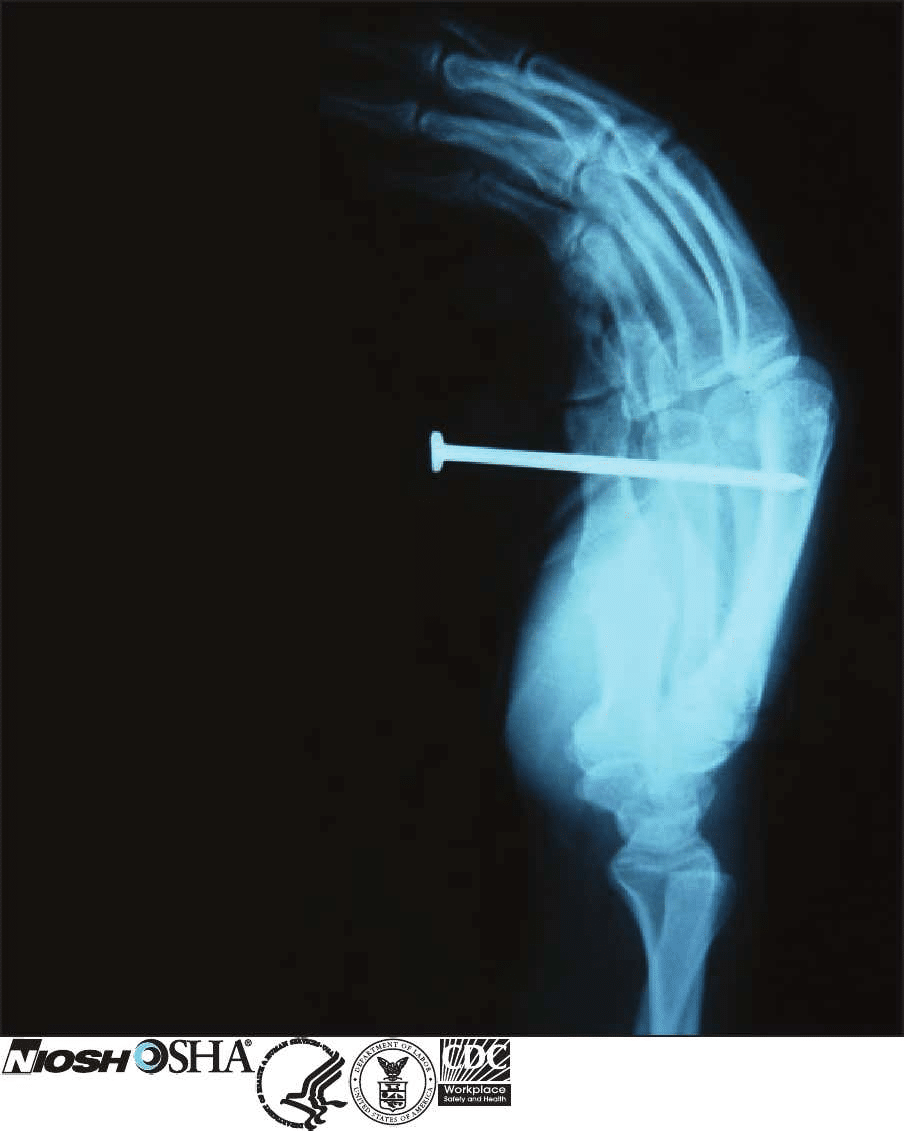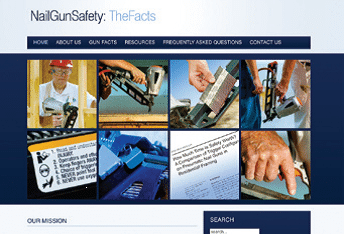Prevention of Nail Gun Injuries in Residential Construction (Completed – 2009-2014)
Hester Lipscomb, PhD
Duke University
Durham, NC
Ph: 919-684-8175
[email protected]
Research Team
Carpenters District Council of Greater St. Louis and Vicinity; Carpenters Joint Apprenticeship Programs, St. Louis, Mo., and Belleville, Ill.; Mark Fullen, EdD, West Virginia University; West Virginia Home Builders Association.
It seems like every day we see potentially devastating nail gun injuries reported in the press. As Dr. Lipscomb’s work has amply demonstrated, the combination of powerful pneumatic nailers, heavy framing nails, and contact-trip triggers adds up to severe injury for thousands of construction workers every year.
A nail gun with a sequential trigger requires users to depress the nose of the gun against the work before pulling the trigger, making an accident highly unlikely. However, many construction workers continue to work with “contact trip” nail guns (or “bump guns”) that permit users to hold down the trigger and “bump” the gun against a surface to fire it, increasing the chances of an accidental discharge substantially.
Users of tools with a contact-trip trigger face twice the risk of acute injury than users of tools with a sequential trigger. It’s far too easy to “bump” a body part or a coworker instead of a piece of lumber or millwork. “Bump fire” guns will also inadvertently discharge a nail if the tip contacts anything following the recoil that is associated with firing. Frame carpenters, who work with heavy framing nails, are at special risk of severe injury.
Interventions among St. Louis area carpenters, in partnership with the Carpenters Union and the Homebuilders Association, have proven highly effective. Increased use of tools with sequential triggers combined with improved early training in the apprenticeship school have slashed injury rates by approximately 80% in the target population. Researchers have continued surveillance to determine if sequential trigger tool use poses an increased work-related musculoskeletal disorders (WMSD) hazard; no evidence of increased WMSD hazard has been found.
The research team has partnered with investigators at WVU to test this approach with non-union builders/framers in that state. Baseline data from builders in West Virginia show markedly higher injury rates among those surveyed than currently seen in the Midwest. The team has developed and delivered a train-the-trainer to 15 individuals from non-union residential building companies using a number of the tools available on the website www.nailgunfacts.org, an employer guidance document jointly published by NIOSH and OSHA (a document largely informed by the team’s own research findings), and a CPWR Hazard Alert pocket card.
An obvious engineering solution to the problem exists: eliminating the contact-trip trigger altogether. The team continues to pursue a dialogue with manufacturers, OSHA, NIOSH, and the Consumer Products Safety Commission to explore this option.
- Researchers demonstrated a marked reduction in nail gun injury rates in the Midwest associated with increased use of tools with sequential triggers and early training of users. This has been accomplished without increasing musculoskeletal injury complaints.
 www.nailgunfacts.org – the team’s repository for news and information on nail gun injuries and safety continues to be updated with news items. The site is receiving more than 2,000 unique visits per day, including a growing number of international visitors. The site offers materials for workers, contractors, academics and others with occupational safety interests. Training videos are frequently downloaded from the site.
www.nailgunfacts.org – the team’s repository for news and information on nail gun injuries and safety continues to be updated with news items. The site is receiving more than 2,000 unique visits per day, including a growing number of international visitors. The site offers materials for workers, contractors, academics and others with occupational safety interests. Training videos are frequently downloaded from the site.- The team has worked with CPWR on distribution of Hazard Alert cards on Nail Guns for use in toolbox talks and safety meetings, and with NIOSH and OSHA on circulation of the nail gun guidance document informed by the team’s research that is available in English and Spanish.
- Working with OSHA and NIOSH partners, Dr. Lipscomb has led webinars for American Society of Safety Engineers and Occupational Health & Safety Magazine audiences.
 Working with collaborators at West Virginia University, Dr. Mark Fullen has developed a train-the-trainer safety program to try to improve nail gun safety in the non-union sector. WVU has held four train-the-trainer sessions open to all companies willing to participate in surveys;
Working with collaborators at West Virginia University, Dr. Mark Fullen has developed a train-the-trainer safety program to try to improve nail gun safety in the non-union sector. WVU has held four train-the-trainer sessions open to all companies willing to participate in surveys;
15 have participated so far.
- Researchers demonstrated a marked reduction in nail gun injury rates in the Midwest associated with increased use of tools with sequential triggers and early training of users. This has been accomplished without increasing musculoskeletal injury complaints.

www.nailgunfacts.org – the team’s repository for news and information on nail gun injuries and safety continues to be updated with news items. The site is receiving more than 2,000 unique visits per day, including a growing number of international visitors. The site offers materials for workers, contractors, academics and others with occupational safety interests. Training videos are frequently downloaded from the site.
- The team has worked with CPWR on distribution of Hazard Alert cards on Nail Guns for use in toolbox talks and safety meetings, and with NIOSH and OSHA on circulation of the nail gun guidance document informed by the team’s research that is available in English and Spanish.
- Working with OSHA and NIOSH partners, Dr. Lipscomb has led webinars for American Society of Safety Engineers and Occupational Health & Safety Magazine audiences.
 Working with collaborators at West Virginia University, Dr. Mark Fullen has developed a train-the-trainer safety program to try to improve nail gun safety in the non-union sector. WVU has held four train-the-trainer sessions open to all companies willing to participate in surveys;
Working with collaborators at West Virginia University, Dr. Mark Fullen has developed a train-the-trainer safety program to try to improve nail gun safety in the non-union sector. WVU has held four train-the-trainer sessions open to all companies willing to participate in surveys;
15 have participated so far.


